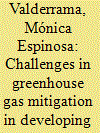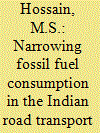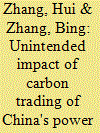|
|
|
Sort Order |
|
|
|
Items / Page
|
|
|
|
|
|
|
| Srl | Item |
| 1 |
ID:
162917


|
|
|
|
|
| Summary/Abstract |
CO2eq emission scenarios for the Colombian transport sector were estimated for 2010–2050. We used a marginal abatement cost approach to assess an emission mitigation pathway. For this purpose, we constructed a carbon emission accounting model linking travel demand to vehicle stock, fuel consumption, and emissions for the Colombian transport sector. Actions related to energy efficiency, fuel switching, new engine technologies and modal change were considered. The analyzed measures have the potential to reduce the cumulative emissions by 8% and 18% under the BAU scenario through 2030 and 2050, respectively. Mitigation costs are high and imply annual capital costs that range from 0.5% to 4% of the national GDP. Gains in efficiency as well as synergy with other sector objectives might help justify some of the actions in financial terms. Non-technological actions, such as high public transit participation in the urban modal share and reorganization of the freight system, play a significant role in attaining low-carbon transport systems in Colombia.
|
|
|
|
|
|
|
|
|
|
|
|
|
|
|
|
| 2 |
ID:
177364


|
|
|
|
|
| Summary/Abstract |
Carbon policies differentiated according to regional disparities have been recognized and recommended. However, the air quality co-benefits of differentiated policies remain unclear. Here we combine a multi-regional dynamic computable general equilibrium (CGE) model and an extend response surface model (ERSM) to investigate the impact of nationally uniform and subnationally differentiated carbon pricing policies on fine particulate matter (PM2.5) concentrations in China. All policies examined lead to the same accumulated national CO2 emissions (2020–2050), with the 2030 emissions attaining China's national abatement target. We find that, when subnational policies differentiated according to provincial PM2.5 concentrations are implemented, the higher-than-average carbon price over more polluted provinces results in twice as much reduction in CO2 and air pollutant emissions in 2050 as the national policy. As a result, the subnational policies cause larger PM2.5 concentration reductions in these provinces (9%–18%) than the national policy (7%–11%). Also, the subnational policies eliminate high PM2.5 exposure of over 45 μg/m3 which 12% people suffer from under the national policy. The subnational policies substantially reduce regional disparity in PM2.5 pollution and hence improve environmental equity. The results suggest that subnationally differentiated carbon policies are a promising instrument to mitigate severe pollution and promote environmental equity.
|
|
|
|
|
|
|
|
|
|
|
|
|
|
|
|
| 3 |
ID:
188542


|
|
|
|
|
| Summary/Abstract |
Road transportation accounts for 56% of India's transportation sector's CO2 emissions. Reaching carbon neutrality before 2070 requires the deep decarbonization of this sector. This study assesses the potential of battery electric vehicles (BEV) and fuel-cell vehicles (FCV) as the least-cost pathway toward carbon neutrality. We estimate the future demand for passenger and freight services and evaluate the impact of EV policies using the Integrated Model of Energy, Environment, and Economy for Sustainable Development/Technology (IMED/TEC). The study covers road transport emissions, energy, and air pollution transitions under four scenarios, including reference, low, medium, and high penetration of BEV and FCV, which align with the decarbonization target agreed upon under India's national policy. Results show that the carbon neutrality target would be challenging with BEV alone in road passenger and freight transportation because it is less efficient. Combined penetration of BEV and FCV can reduce air pollutant emissions significantly. Operative implementation of FCV could diminish more than 96% of the total road transport CO2 emissions. The analytical framework also proposes local climate change policies towards a carbon neutrality strategy to escalate the share of BEV and FCV in the Indian road transport sector.
|
|
|
|
|
|
|
|
|
|
|
|
|
|
|
|
| 4 |
ID:
134362


|
|
|
|
|
| Summary/Abstract |
China needs to reduce its carbon emissions if global climate change mitigation is to succeed. Conventional economic analysis views cutting emissions as a cost, creating a collective action problem. However, decarbonization can improve productivity and provide co-benefits that accord with multiple national policy objectives. We track China's progress in reducing the emissions intensity of the economy, and construct a macro scenario with China's carbon emissions peaking in the 2020s. Investment in greater energy productivity and economic restructuring away from heavy industries can bring productivity gains, and decarbonization of energy supply has important co-benefits for air pollution and energy security. Combined with lower climate change risks and the likelihood that China's actions will influence other countries, this suggests that cutting carbon emissions is not only in China's self-interest but also in the global interest. To properly identify the true costs and benefits of climate change action requires new thinking in economic analysis.
|
|
|
|
|
|
|
|
|
|
|
|
|
|
|
|
| 5 |
ID:
177148


|
|
|
|
|
| Summary/Abstract |
Carbon trading is considered a strategy for reallocating carbon permits and reducing abatement costs that may also change energy consumption and the distribution of atmospheric pollution emissions, resulting in environmental health benefits or damage on a regional scale. In this research, we use an agent-based model to construct a national carbon emissions trading market of the power sector based on the year of 2013, and simulate the key atmospheric pollution emission patterns and the corresponding environmental health effects. We find that compared with a command and control policy, the carbon trading policy is able to reduce the CO2 emissions and save abatement costs by approximately 63.53 RMB/ton. Meanwhile, the results show the carbon trading policy would synergistically reduce PM2.5 emissions by 1.55 million tons. Addition, we use a simplified exposure-response model to estimate health benefits by synergistically reducing PM2.5 emissions, and find that the carbon trading policy would decrease 45,200 cases of all-cause mortality and generate 307.07 billion RMB in environmental health benefits. The co-benefit accounts for 0.52% of the nation's gross domestic product (GDP) in 2013. However, compared with the command and control policy, carbon trading changes the pollution emission distribution among the different provinces, and results in unintended environmental health damages in some provinces. Setting reasonable trading directions and exchange ratios, increasing stringency of environmental regulations in some provinces with worsening air pollution should be implemented to complement the carbon trading policy.
|
|
|
|
|
|
|
|
|
|
|
|
|
|
|
|
| 6 |
ID:
150734


|
|
|
|
|
| Summary/Abstract |
In 2010, Germany agreed a plan to increase the share of renewables in power consumption to 80% by 2050, and in 2011 the decision was taken to phase-out nuclear power by 2022. This policy is now widely known as the “Energiewende”. While many global observers consider this program to be primarily driven by the need to tackle climate change, the precise political goals of the Energiewende are, by and large, unclear. In our study we compiled a list of 14 goals put forward in political debates and conducted a “mapping” survey among more than 50 policy experts. We asked them to prioritize the goals based on their personal views and provide arguments for their rankings in ensuing interviews. Our main findings are as follows: (i) a large majority named climate protection among the top-level goals of the Energiewende; at the same time, around 80% of all participants also identified additional goals; (ii) when asked if the Energiewende would make sense even if climate change did not exist, two thirds of the participants agreed, which, when taken with the first finding, demonstrates that the goals and motivations driving the Energiewende are more complex than often assumed. We conclude that for the sake of effective and efficient policies and ever rising climate policy ambition, a public debate and clear specification of the top-level goals are indispensable.
|
|
|
|
|
|
|
|
|
|
|
|
|
|
|
|
|
|
|
|
|